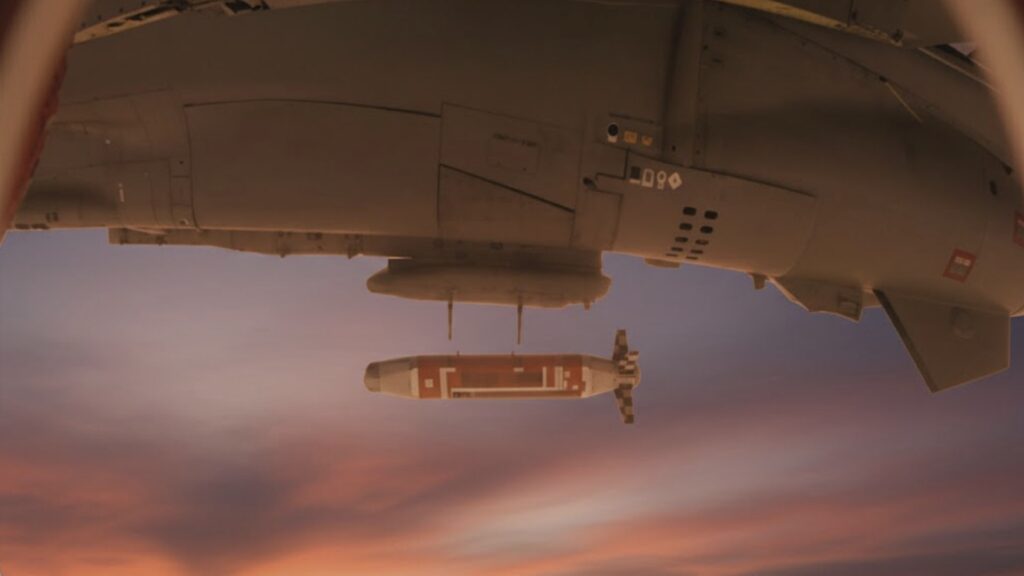SAAW EO is a next-generation long-range stand-off air-to-surface guided bomb developed by the Defence Research and Development Organisation (DRDO). It integrates an advanced Imaging Infrared (IIR) seeker on its nose to achieve pinpoint accuracy against both stationary and moving targets. The aerodynamic design and extended wings give the weapon a range exceeding 100 kilometres, allowing combat aircraft to engage targets from various altitudes while staying beyond enemy air defence range.
This system enables precision strikes against high-value enemy assets, including air defence radars with shoot-and-scoot capabilities. Engineers designed SAAW EO to provide superior engagement flexibility, high hit probability, and reduced platform vulnerability during missions.
SAAW EO : Guidance Architecture and Seeker Function
The nose-mounted cooled IIR seeker Mk-I plays a crucial role in achieving terminal accuracy. The weapon initially uses an Inertial Navigation System (INS) coupled with GPS for midcourse guidance. Once it reaches the designated terminal phase, the system performs a Lock-On-After-Launch operation and seamlessly hands over guidance to the EO seeker.
During August 2023 trials, DRDO successfully demonstrated the handover of guidance from INS-GPS to the seeker. The seeker’s scene-matching algorithm corrected target location errors in real time and ensured accurate terminal impact. This successful demonstration validated the Lock-On-After-Launch functionality and the high-precision target-tracking capabilities of the SAAW EO.
SAAW EO : Advanced Sensors and Image Processing
The EO seeker of the SAAW EO captures high-resolution thermal imagery and processes it in real time. The onboard processor performs correlation with stored reference images using scene-matching algorithms. Engineers implemented advanced Kalman filters and motion compensation techniques to stabilize imagery and eliminate navigation drift.
This real-time data fusion between INS, GPS, and the seeker ensures continuous and precise trajectory correction during the flight. Additionally, the seeker’s robust design allows it to perform effectively under variable lighting, temperature, and weather conditions.
Aerodynamic Design and Glide Efficiency
The SAAW EO features deployable wings that generate lift during flight, increasing its lift-to-drag ratio and range. The designers optimized the control surfaces and center of gravity to maintain aerodynamic stability during glide and terminal approach. Control actuators provide precise pitch and bank modulation to support seeker-based target acquisition.
The weapon can be launched from multiple altitudes and speeds, giving pilots flexibility in selecting release envelopes. High-altitude release enhances stand-off distance and platform survivability. The onboard flight management software continuously computes optimal release points for maximum strike accuracy.
Target Engagement and Moving Target Capability
SAAW EO’s electro-optical seeker enables dynamic target tracking and engagement of moving targets. The seeker continuously updates target position through interframe image correlation and motion prediction algorithms. This allows the weapon to strike targets that relocate after detection, including mobile radar units or missile launchers employing rapid repositioning tactics.
By combining proportional navigation laws with image-based feedback control, the seeker maintains a stable lock even if the target performs evasive maneuvers. This capability marks a major leap over earlier variants limited to static target engagement.
Integration and Tactical Deployment
The SAAW EO integrates seamlessly with multiple fighter aircrafts. Crew can upload mission data and target coordinates using onboard avionics or datalinks before launch. The system supports mid-flight target updates, ensuring adaptability in dynamic battlefield conditions.
The Indian Air Force and Navy can employ SAAW EO for strategic suppression of enemy air defences, runways, communication nodes, and high-value tactical targets.
Development Journey and Testing Milestones
The baseline Smart Anti-Airfield Weapon (SAAW) project began in 2013 under DRDO’s leadership. The first successful test occurred in May 2016, followed by additional validation tests in November 2017 and December 2017. Between 16 and 18 August 2018, three consecutive successful trials demonstrated the weapon’s reliability and guidance precision.
In September 2020, the Indian Government approved the SAAW for induction into the Indian Air Force and Navy. The EO variant, featuring an advanced seeker, underwent successful release trials in August 2023, confirming its operational readiness.

SAAW EO represents a major milestone in India’s precision-guided munitions program. It combines long-range capability, image-based guidance, and autonomous target recognition into a compact glide bomb. The successful integration of an electro-optical seeker makes it a formidable asset for the Indian Air Force and Navy.
By enabling accurate strikes from safe distances and against agile targets, SAAW EO strengthens India’s tactical and strategic strike capabilities in modern warfare.
